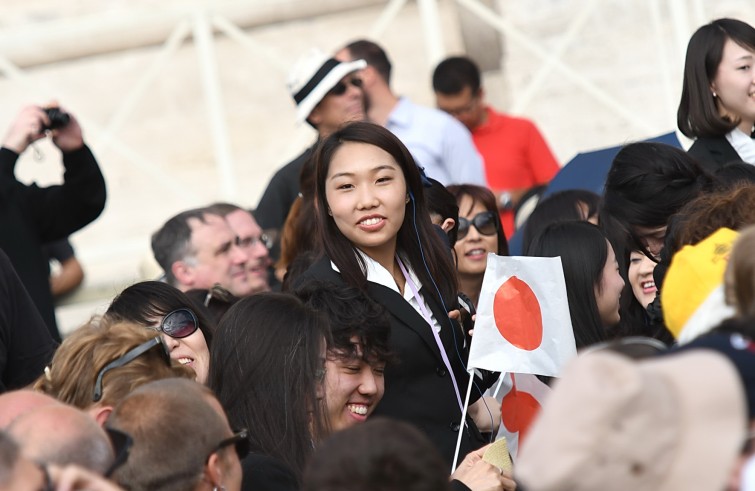
Tokyo – Each year, the Cultural Affairs Agency of Japan draws up and publishes a report called “Shūkyō nenkan”, whose purpose is to “count” the total number of believers registered with the various religious entities in the country, divided into four main groups: Shintoists, Buddhists, Christians and other religions. Based on 2021 data provided by the various faith communities for the 2022 study, released this year, only those categorised as “Christians” by the Agency registered an increase over the previous year, with 52,290 more members, bringing the total to 1,967,584.
This increase occurred for the second year in a row, but it does not apply to the Catholic Church,
which, with its 431,100 members, registered 3,983 less members, although it remains the largest among numerous Christian denomination that range from the countless branches of Protestant churches to the Japanese Orthodox Church and other Christian-based communities.
Shintoists and Buddhists are the largest faith communities, with 87,236,585 and 83,242,856 members respectively, but their numbers have declined, as has the ‘other religions’ group. As in previous years, the total number of members of the four faith communities registered in the Shūkyō nenkan 2022, amounting to 179,560,113, outnumbered Japan’s total population of approximately 126 million. This figure is only seemingly inconsistent, considering Japanese people’s distinctive approach to religion, whereby they can simultaneously join Shintoism and Buddhism without having to undergo any specific initiation rite and with no limits in terms of overlapping, thereby giving rise to a somewhat statistical short-circuit.
Although Christians in Japan represent slightly more than 1% of the overall population, approximately 0.34% of whom are Catholics, the Japanese people are familiar with the Christian culture.
In fact, they learn about the history of Christianity already in school, and everyone has heard of personalities such as Mother Teresa of Calcutta. When they grow up, they become fascinated with Christian art and music, gospel choirs and Schubert’s Ave Maria above all, and when travelling abroad, they are keen to visit churches and museums displaying some of the great artworks painted by Christian artists. Moreover, Christmas has become a popular event among people of all ages who, even if they are not baptised, will frequently attend Christmas Mass. Similarly, many non-Christian couples yearn to celebrate their marriage according to the Catholic ‘style’, so they turn to professional companies to fulfil their wish. These companies organise ceremonies in buildings that have been converted into chapels for ceremonies, complete with wedding officiants dressed as priests who chair the ceremony, reciting the text of the traditional rite of the Catholic marriage.
An article that appeared a few years ago on an online news outlet read: “The Japanese people have an interest in a Christianity without the ‘Gospel'”.
Despite there being three archdioceses and 14 dioceses in the Japanese archipelago, where, a survey found, one in ten Japanese attended Catholic schools or universities in the course of their lives, “it’s hard to see successful missionary activities,” Archbishop Tarcisio Isao Kikuchi of Tokyo said in an interview with Catholic News Agency in 2019. In a document released two years later, the Japanese bishops described the Catholic community as facing a ‘stalemate’, “a consequence of declining birth rates, an ageing population, changes in the family context, dwindling religious beliefs, and young people leaving the Church”, also resulting in a drop in vocations. In this context, the pastoral care of young people and the pastoral care of immigrant baptised persons are deemed fundamental for the future of the Japanese Catholic community, in order to welcome them into parishes and to spread among the faithful the awareness that the Church in Japan is not a Japanese Church, but a universal Church.
However, according to Tokyo Archbishop Kikuchi, in order to restore impetus to missionary ministry, which the bishops themselves described as being in decline, alongside Catholic schools and universities – whose specific identity is also diminishing – and the fundamental presence of charity agencies such as Caritas Japan, whose service bears witness to the values of the Gospel to all those who never had the opportunity to be exposed to the Christian faith,
the testimony of Catholic individuals and families who moved to Japan as missionaries is ” extremely important.”
Indeed, testimony, a translation of the Greek word ‘martyría’, has guided Gospel proclamation in this land from the very beginning, a land that Fr Antonello Iapicca, serving as missionary in the Land of the Rising Sun for the past thirty years, described in an interview as a “politely Christ-rejecting society.” With this expression, he too wished to underline the difficulties inherent in evangelisation, which he explained as follows: “Christianity can hardly spread because the imparted education, based on Buddhism, forms a perfect citizen who, naturally, takes precedence over being a Christian.” He identified testimony as the preferential way to proclaim the Good News:
“A Christian family with three or four children in Japan is a powerful testimony today. For a Christian to say to his or her office manager ‘I can’t work on Sundays because the family comes first’ is a tremendous revolution.”
At Pentecost Sunday of 2017, Pope Francis said, “The Church is missionary by nature; otherwise, she would no longer be the Church of Christ, but one group among many others that soon end up serving their purpose and passing away.” The Japanese Church has a pressing need to recover this original nature. “We firmly believe that the ‘missionary dimension’ of priestly service must be strengthened,” the bishops stated. “That is why it is necessary to encourage them to find ways to extend their service beyond the community of believers and reach out to the hearts of those who are longing for the Gospel. This means changing the paradigm from ‘administrator’ to ‘shepherd’, from ‘shepherd’ to ‘missionary’.”












